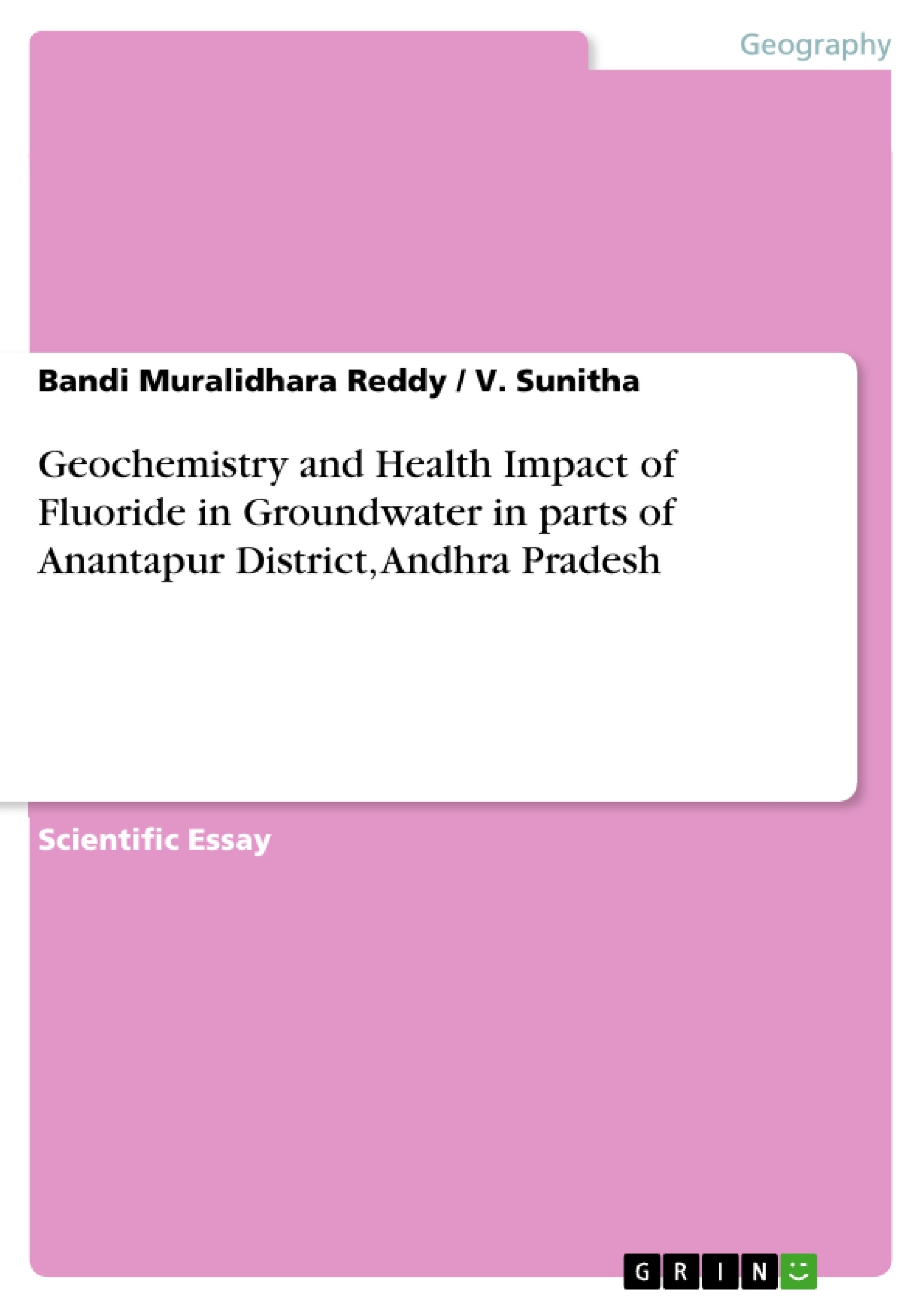Groundwater is an important water resource in India for domestic, irrigation and industrial purposes. Swift unscientific and unsuitable groundwater developments in India suitable to even increasing population, urbanization, industrialization alters. The hydrological and geochemical environment of aquifers leads to groundwater pollution. Groundwater pollution suitable to geogenic and anthropogenic factors causes the groundwater non-potable and utilization of this water lead to health problems. Access of drinking water is measured by the number of people who has a reasonable means of getting an adequate amount of water that is safe for drinking. There is a substantial shortfall in the availability of potable water in less developed countries, primarily arising from contamination and pollution.
Endemic fluorosis is a major health issue occurring due to utilization of fluoride in groundwater is nationally important. Fluoride ion in drinking water is known for both beneficial and detrimental effects on health. It is essential for normal mineralization of bones and formation of dental enamel with presence in small quantity. However, when consumed in higher doses (>1.5mg/l), it leads to dental fluorosis or mottled enamel and excessively high concentration (>3.0mg/l) of fluoride may lead to skeletal fluorosis. Presence of high concentration of fluoride in groundwater is a major problem in many countries as it causes health related problems.
The selected study area is located in Southeastern part of Anantapur District, Andhra Pradesh. The geographical position of the Peninsula renders it, the driest part of the state and hence, agriculture conditions are more often precarious. The study area mainly exposes peninsular gneisses of Archean age consisting of pink granites, schists, composite gneisses of Dharwar age, intruded by a few pegmatite dykes. The major geomorphic units of the study area are mainly divided into Denudational Hills, Dissected pediments, Pediplain, and alluvium. The important rivers in the district are Penna, Chitravathi, Vedavathi and Hagari. The normal rainfall of the district is 553 mm by which it secures least rainfall when compared to Rayalaseema and other parts of Andhra Pradesh. The area experiences a semiarid climate with a moisture index of 33.7% with mean monthly temperatures of 17°C in January to 42°C in May.
Inhaltsverzeichnis (Table of Contents)
- CHAPTER 1: INTRODUCTION
- 1.1 Background to the Research
- 1.2 Research Objectives
- 1.3 Review of Literature
- 1.3.1 International Status
- 1.3.2 National Status
- CHAPTER 2: STUDY AREA
- 2.1 Geomorphology
- 2.2 Hydrogeology
- 2.3 Geology
- CHAPTER 3: MATERIALS AND METHODS
- 3.1 Field Work
- 3.2 Sample Collection
- 3.3 Experimental Procedures
- 3.3.1 Determination of Fluoride
- 3.3.2 Determination of other parameters, methods and instruments
- CHAPTER 4: RESULTS AND DISCUSSIONS
- 4.1 Beneficial effects
- 4.2 Impact of fluoride on human health
- 4.2.1 Dental Fluorosis
- 4.2.2 Skeletal Fluorosis
- 4.3 Total fluoride ingestion
- 4.4 Nutritional status
- 4.5 Dietary factors
- 4.6 Factors affecting the natural fluoride concentrations
- 4.6.1 Sources
- 4.7 Fluoride
- 4.7.1 Dental Fluorosis
- 4.7.2 Skeletal Fluorosis
- 4.7.3 Fluoride Hydrogeochemistry
- 4.8 Spatial analysis of groundwater quality
- 4.8.1 Fluoride
- 4.8.2 pH
- 4.8.3 Electrical Conductivity
- 4.8.4 Total Dissolved Solids
- 4.8.5 Total Hardness
- 4.8.6 Sodium
- 4.8.7 Potassium
- 4.8.8 Calcium
- 4.8.9 Magnesium
- 4.8.10 Total Alkalinity (CO3 - and HCO3 - )
- 4.8.11 Sulphate
- 4.8.12 Chloride
- 4.8.13 Nitrate
- 4.9 Correlation Analysis
- 4.10 Chemical Classification
- 4.11 Classification of groundwater for irrigation purpose
- 4.11.1 Percent Sodium (%Na)
- 4.11.2 Residual Sodium Carbonate (RSC)
- 4.11.3 Sodium Adsorption Ratio (SAR)
- 4.11.4 Piper Tri-linear Diagram
- 4.12 Defluoridation Techniques
- Sources, distribution, and geochemical behavior of fluoride in groundwater.
- Impact of fluoride on human health (dental and skeletal fluorosis).
- Spatial distribution of fluoride and other physicochemical parameters in groundwater.
- Suitability of groundwater for irrigation purposes.
- Defluoridation techniques for removing fluoride from groundwater.
- Chapter 1: Introduction: This chapter provides background information on the research, outlines the objectives of the study, and presents a review of existing literature on fluoride contamination in groundwater, both internationally and within India.
- Chapter 2: Study Area: This chapter describes the geological, geomorphological, and hydrological characteristics of the study area in southeastern Anantapur district, Andhra Pradesh.
- Chapter 3: Materials and Methods: This chapter details the methods used to collect and analyze water samples, including field work, sample collection procedures, and the analytical techniques employed to measure various physicochemical parameters.
- Chapter 4: Results and Discussions: This chapter presents the findings of the study and discusses the implications of the results. The chapter explores the beneficial effects of fluoride at moderate levels, the health risks associated with high fluoride intake, and the factors contributing to fluoride enrichment in groundwater, including sources, geochemical processes, and the correlation of fluoride with other parameters.
Zielsetzung und Themenschwerpunkte (Objectives and Key Themes)
The main objective of this study is to assess the sources, distribution, and geochemical behavior of fluoride in groundwater in the Mudigubba, Nallamada, and Kadiri mandals of Anantapur district, Andhra Pradesh, India, to understand the impact of fluoride on human health, and to propose defluoridation techniques for the area.
Zusammenfassung der Kapitel (Chapter Summaries)
Schlüsselwörter (Keywords)
The main keywords and focus topics of this study are: fluoride, groundwater, dental fluorosis, skeletal fluorosis, geochemistry, hydrogeology, spatial analysis, GIS, defluoridation, bioadsorbents, mint leaves, drinking water quality, irrigation water quality, Anantapur district, Andhra Pradesh, India.
- Quote paper
- Bandi Muralidhara Reddy (Author), V. Sunitha (Author), 2015, Geochemistry and Health Impact of Fluoride in Groundwater in parts of Anantapur District, Andhra Pradesh, Munich, GRIN Verlag, https://www.grin.com/document/455534



